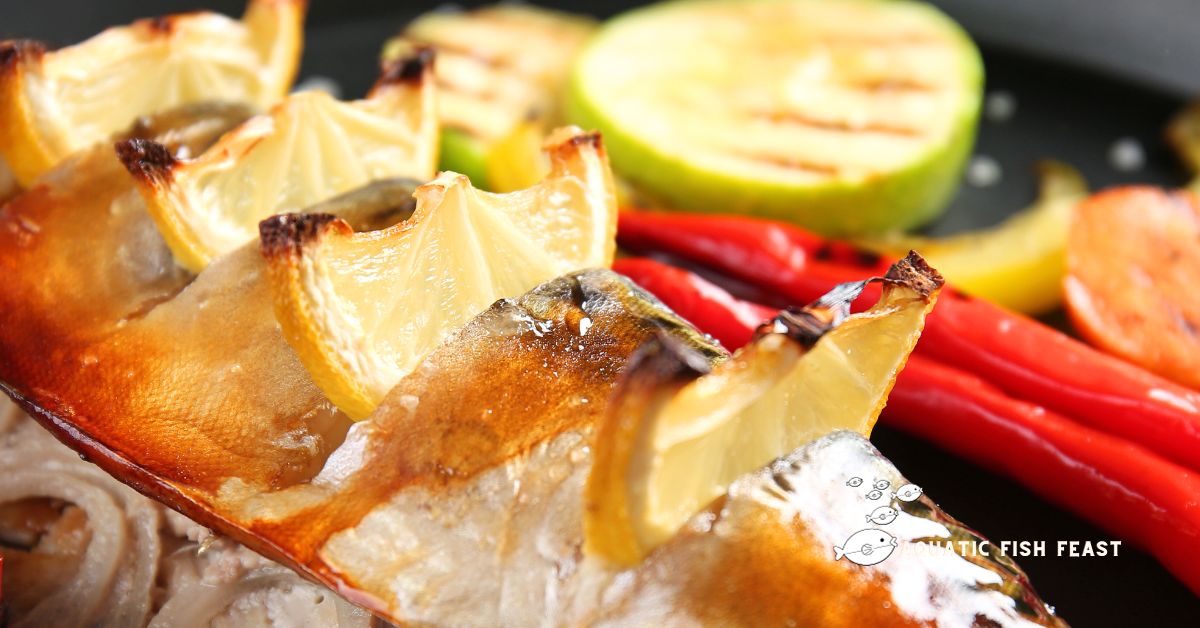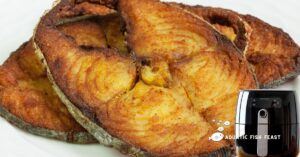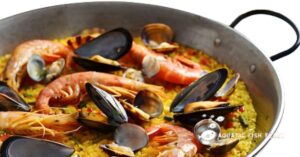Do you want to know how to pan-fry fish recipe? Yes, I’m looking for a recipe for pan-fried fish. Is fish a common occurrence in your home? If not, there are a tonne of reasons why it should be.
Whether a fish novice or a seasoned fish pro, this pan-fried fish recipe is a must-try. It’s ready in under 20 minutes and delicious!
But that is not all; however, as you read further, I will explore how to pan-fry your fish recipes.
Now, let’s get started.
Table of Contents
What Are The PAN FRYING FISH Recipe Ingredients And Instructions
Below are the pan-frying fish ingredients and instructions:
Ingredients:
Seafood Ingredients
400-500 grams of whole fish (such as mackerel or sardine)
Or 180 200 grams of filets (such as lemon sole or pollock)
Other Ingredients
Sunflower oil
Salt and pepper
Lemon or lime
Instructions:
1. Firstly, pat the fish dry with clean kitchen paper and make 3 or 4 shallow slashes across the skin side of the fish and portion the fillets if necessary.
2. Heat a nonstick frying pan or skillet until hot; add olive or sunflower oil.
3. Lay the fish into the pan away from your skin side down so that any oil that splashes from the pan doesn’t burn you.
4. Allow the fish to start to crisp up, turn the heat down, and allow it to cook until it is almost finished cooking.
5. If you are cooking fillets, turn over onto the flesh side and immediately turn the heat off.
6. The pan will have sufficient residual heat to finish cooking.
7. Depending on the thickness of the fish, roast the whole fish in a hot oven (200 degrees C) for the appropriate amount of time.
8. Place your fish in the center of the warm plates after decorating them with lines of balsamic glaze.
9. Add sea salt and black pepper to taste, then squeeze some lemon juice over the fish.
10. Add extra virgin olive oil to taste.
11. Cooking Tip: As fish fillets start to cook, the cut sides will change from raw opaque to creamy white cooked; the more the color changes, the closer they are to being cooked.
12. When light pressure on a fillet starts to separate its flakes, it is cooked.
What Kind Of Pan Should I Use For My Pan Frying Fish Recipes
This is one instance where I often turn to a nonstick skillet. It makes the already simple cooking procedure even more approachable, and I’m less concerned about the fish shredding and clinging to the pan.
However, a cast-iron or stainless steel pan makes the fish slightly more golden and crispy, which I enjoy. Use a little bit more oil than usual if using one of these skillets to prevent the fish from sticking.
Use the pan you have and are most accustomed to using after all this. It doesn’t have to be flawless because this fish is designed to be a quick evening supper rather than anything extravagant.
Think of these fragments as fish cracking if the fish flakes apart when you flip it or if you leave some behind.
How To Cook Fish Recipes In A Frying Pan
This step-by-step tutorial on fried fish recipe from Allrecipes Community Member crabbyjean. To fit your preferences, you may alter the fish kind and spices.
Take this as a starting point, but be creative with your selections:
1. Choose Your Fish
Not every fish was designed to be fried. Most varieties of white fish, which have a neutral flavor and aren’t highly greasy, are suitable.
Cod, tilapia, catfish, halibut, trout, striped bass, flounder, and perch are popular options. You may use fresh or frozen; remember to account for thawing time if you use frozen.
2. Fish Preparation
The ideal serving size for a family of four is one pound of skinless or four 4-ounce skinless fillets (approximately 12 inches thick). If you’re starting with frozen fish, defrost it for 24 hours in the fridge before cooking.
If your fillets are thicker than 12 inches thick, move them to a cutting board and slice them lengthwise to reach the appropriate thickness – you’ll end up with crispier fish!
3. Make the breading.
You may express your creativity here. Add, or substitute any ingredients as you see fit.
Beat one egg with 1/3 cup milk in a small bowl.
Use a separate dish to mix 12 cups of breadcrumbs, two teaspoons minced garlic, two teaspoons roasted onion flakes, one teaspoon blackened seasoning (like Old Bay), two pinches crushed red pepper flakes, 14 teaspoons freshly ground pepper, and 14 teaspoons freshly ground sea salt.
4. Dress the Fish.
Next, carefully press each fillet into the crumb mixture on both sides after dipping it in the egg mixture. To help the crumbs set, place the coated fillets on a platter in the refrigerator for about 15 minutes.
5. Fry the Fish.
Read on to learn why the oven must be preheated to 300°F.
Cast iron is excellent for uniform cooking and crispy crusts. In a big pot, melt two tablespoons of butter and 1.5 teaspoons of olive oil over medium heat.
Brown the two fillets in skillets for three minutes per side.
Flip the fish over carefully with a pair of tongs. After removing it with utensils, drain it on a platter covered in paper towels. Proceed with the remaining two fillets.
How Long Does Fish Take In A Frying Pan
Pan oil should sizzle when adding fish. FISH till the bottom is golden brown. To answer “How long does fish fry?”: Pan-frying fillets take 3–4 minutes on each side.
When the first side is brown, flip the fish over and hold it with tongs or a large metal spatula and fork. Be careful not to spill fat. The fish fat should still be sizzling when flipped.
When tested with a fork, it will take 3 to 4 minutes to cook the opposite side until golden brown and the fish flakes.
Stack two or three pieces of paper towel on a plate to soak up the oil. Carefully use a spoon to move each piece of cooked fish to the paper towels to drain. Turn the fish over to let both sides dry.
Keep the fried fish warm by baking it on a sheet while you make the rest.
How To Fry Fish In A Pan With Oil
Below are five tips that will make you a better fish fryer if you follow them.
1: Keep oil at the right temperature
It is essential to keep the oil at the right temperature. Most fish and shellfish should be fried at 350 to 375 degrees. Smaller, thinner pieces should be cooked at about 375, and bigger, thicker pieces should be cooked at about 350.
2: Don’t make it too complete!
As food is put into a pan, the oil temperature drops. Work in small batches; if you need to, you can warm all the fish.
A metal cookie sheet should be in the oven at 300 degrees. Kindly place the finished meal on the cookie sheet and bake for 2–3 minutes.
3: Finish with salt
Don’t put too much salt in your flour or batter. Instead, sprinkle salt on your fish when it comes out of the pan. A lot more will stick to table salt than to kosher salt.
4: Don’t cook too long.
Once the fish is cooked, it will stop releasing steam, and oil will seep into it, making it greasy. When it’s done, your eyes and ears will tell you.
When the bubbles stop moving and the food stops boiling, it’s ready to eat. Most fish will be ready in less than 3 minutes.
5. Don’t use paper towels.
You should put food on a metal rack to dry when you take food from the pan. When you put it on paper napkins, the crust will steam from below, making the sides soggy, and more likely that the coating will fall off.
Final Thought
Now that we have established how to pan-fry fish recipe, If you aren’t careful, hot oil can hurt you.
Please don’t walk away from the pot of oil while it’s on the stove. Ensure you have a lid and baking soda handy if needed. (The only safe way to extinguish an oil fire is to smother it with a lid or baking soda.
It will get worse if you spray it with water.) If a grease fire starts, turn off the cooker immediately and try to remove it by smothering it if that doesn’t work.
Other Articles:




